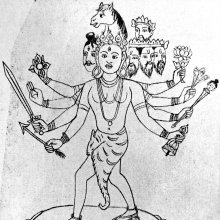Paramashva, Paramāśva: 3 definitions
Introduction:
Paramashva means something in Buddhism, Pali, Hinduism, Sanskrit. If you want to know the exact meaning, history, etymology or English translation of this term then check out the descriptions on this page. Add your comment or reference to a book if you want to contribute to this summary article.
The Sanskrit term Paramāśva can be transliterated into English as Paramasva or Paramashva, using the IAST transliteration scheme (?).
Images (photo gallery)
In Buddhism
Tibetan Buddhism (Vajrayana or tantric Buddhism)
Source: archive.org: The Indian Buddhist Iconography1) Paramāśva (परमाश्व) refers to one of the various emanations of Akṣobhya commonly depicted in Buddhist Iconography, and mentioned in the 11th-century Niṣpannayogāvalī of Mahāpaṇḍita Abhayākara.—His Vāhana is four Gods and four Goddesses; he has eight arms, four faces and four legs.—Paramāśva “great horse” is another form of Hayagrīva “horse-neck” as the word “aśva” in Paramāśva indicates.
Paramāśva is described in the Niṣpannayogāvalī as follows:—
“The worshipper should think himself as Paramāśva, of red colour, four-faced, eight-armed and four-legged. The first face with three eyes displays angry passion, the second depicts wrath, the third is the face of Brahmā, and the fourth on the top is green, distorted like a horse with its lower lip beautifully protruding. He wields the double vajra, in one of his right hands with three fingers erect (tripatākā) and in one of his left hands carries the staff with the double lotus. Another right hand, with three fingers erect, is raised upwards, and the other left carries the Śakti (dart). The remaining two right hands carry the khaḍga and the arrow, and the remaining left carry the staff and the bow. He stands in the pratyālīḍha attitude, and tramples with one of his right legs upon Indrāṇī and Śrī, and with the second Rati and Prīti; with one of the left legs Indra and Madhukara, and with the other left Jayakara and Vasanta”.
2) Paramāśva (परमाश्व) is another name for Mahābala: one of the ten deities of the quarters (Dikpāla) presiding over the Vāyu-corner, according to the same Niṣpannayogāvalī.—His Colour is blue; he has three faces and six arms.—The seventh deity in the series is Mahābala, who is the presiding deity of the intermediate corner of Vāyu. [...] In the vajrahūṃkāra-maṇḍala he is given the name of Mahākāla. But in the dharmadhātuvagīśvara-maṇḍala he is known as Paramāśva.
Source: Brill: Śaivism and the Tantric Traditions (tantric Buddhism)Paramāśva (परमाश्व) is the name of a deity, according to the Nāmamantrārthāvalokinī by Vilāsavajra, which is a commentary on the Nāmasaṃgīti.—Accordingly, [while describing Ādibuddha]—“[...] [The Ādibuddha] has five faces. [...] [His five faces] have five [different] colours: dark blue for the east [and forward-facing face], yellow for the south, red for the west, [and] green for the north. On the top (mūrdhan), he has a white face, the face of [the deity] Paramāśva. [...]”.

Tibetan Buddhism includes schools such as Nyingma, Kadampa, Kagyu and Gelug. Their primary canon of literature is divided in two broad categories: The Kangyur, which consists of Buddha’s words, and the Tengyur, which includes commentaries from various sources. Esotericism and tantra techniques (vajrayāna) are collected indepently.
Languages of India and abroad
Sanskrit dictionary
Source: Cologne Digital Sanskrit Dictionaries: Edgerton Buddhist Hybrid Sanskrit DictionaryParamāśva (परमाश्व).—name of a deity: Sādhanamālā 510.7 etc.
Sanskrit, also spelled संस्कृतम् (saṃskṛtam), is an ancient language of India commonly seen as the grandmother of the Indo-European language family (even English!). Closely allied with Prakrit and Pali, Sanskrit is more exhaustive in both grammar and terms and has the most extensive collection of literature in the world, greatly surpassing its sister-languages Greek and Latin.
See also (Relevant definitions)
Full-text: Vishvadaka, Pancavarna, Harita, Pita, Rakta, Murdha, Mukhavat, Nila, Pashcima, Varna, Varnopeta, Shvetamukha, Uttara, Dakshina, Purva, Mahabala, Mahakala.
Relevant text
Search found 2 books and stories containing Paramashva, Paramāśva, Paramasva; (plurals include: Paramashvas, Paramāśvas, Paramasvas). You can also click to the full overview containing English textual excerpts. Below are direct links for the most relevant articles:
The Indian Buddhist Iconography (by Benoytosh Bhattachacharyya)
Lord Hayagriva in Sanskrit Literature (by Anindita Adhikari)
Iconographical descriptions of Hayagrīva < [Chapter 6]

